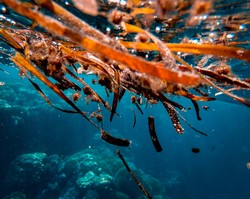As part of the Urban Coast Institute’s Marine & Environmental Speaker Series, environmental lawyer Ethan Prall asked and discussed possible answers in regards to seaweed being a fish, giving a virtual lecture about the growth of the seaweed industry on Tuesday, Nov 10.
Prall, a Washington, D.C.-based environmental lawyer and policy advocate for Latham & Watkins LLP, believes there can be a range of significant environmental benefits from commercial seaweed fisheries, both from live seaweed and products made from it.
“Seaweeds absorb a lot of carbon dioxide and have the potential to be used in products like biofuels that reduce emissions,” he said. “They can also be cultivated through aquaculture or other means to ‘offset’ carbon emissions from other sectors, since they absorb so much carbon dioxide. And, because of their natural properties, they can also help combat negative climate effects like acidification in the ocean.”
Earlier this month, Prall remotely visited Monmouth University’s Urban Coast Institute (UCI). Registered students and faculty joined a Zoom meeting to hear Prall’s lecture, “Is Seaweed a Fish?,” which proposed alterations to the Magnuson-Stevens Act (MSA)—a piece of legislation which regulates coastal US fisheries—to allow for expansion of the seaweed industry.
Prall admits that the fledgling industry is in uncharted waters, but remains optimistic about its potential.
“I think we’ll have to wait and see how much the seaweed industry grows in the coming years in federal waters,” he said. “But, it seems important to minimize regulation of the industry at least initially, because it can have significant climate change benefits.”
The presentation argued that the MSA, which calls for the regulation of coastal fisheries, contains language that allows for seaweed to be harvested in these facilities in addition to organisms that are traditionally considered “fish.”
According to Prall, the Act defines “fish” as: “finfish, mollusks, crustaceans, and all other forms of marine animal and plant life.” “So,” said Prall, “we can see right away that the Magnuson-Stevens Act has language built-in to account for forms of sea life that can be harvested that aren’t strictly ‘fish.’ In fact, NOAA has existing discretion under the Act to let seaweed fisheries grow and experiment without heavily regulating those fisheries, at least at the outset.”
What Prall and his colleagues intend to do, regarding this clause in the MSA, is lobby for the consideration of seaweed cultivation under the same regulations as marine animal aquaculture.
Prall argued that the National Oceanic and Atmospheric Administration (NOAA) can take a “light touch” to its fishery regulations that could benefit the economy and environment by allowing seaweed to be harvested commercially. He explained that there are two main ways to allow for experimental seaweed harvest under the MSA. The first option is to alter regulatory language in the MSA which allows “an individual fisherman” to “participate in [a] fishery unless regulatory action is taken to prohibit [the participation],” as long as proper authorities are notified. In the presentation, Prall suggested that the term “an individual fisherman” be changed to “any person,” thus broadening the scope of individuals who can use the fisheries and condoning the harvest of certain species of seaweeds.
“The second option,” Prall said, “is less about the regulatory language of the Magnuson-Stevens Act and more about the NOAA and more regional Fishery Management Councils exercising their discretion until management plans can be made for regulating seaweed-specific fisheries.”
“Currently, there is no apparent risk of overfishing seaweed in federal waters,” Prall said. “This is encouraging because that’s what a majority of these fishery management plans (FMPs) are focused on. Since overfishing seaweed is virtually impossible here, the NOAA can allow harvest to go forward without FMPs for now.”
In a 2017 article from the European Journal of Phycology, Michéal Mac Monagail, Lynn Cornish, Liam Morrison, Rita Araújo, and Alan T. Critchley claimed that the seaweed industry’s rapid growth warrants “[t]he increasing demand for seaweeds as food products can only be adequately met by cultivation, and the high production and cultivation costs are offset by the higher market prices achieved for [seaweed].”
Though not in attendance, James Nickels, a Marine Scientist for the UCI, echoed Prall’s sentiment. “On a small scale, seaweed harvesting has been done at various places around the world for centuries with very little impact,” he explained. “As you try to ramp up to large-scale commercial operations there are always pluses and minuses.”
“Seaweed farms can help reduce toxic nutrients in the water, fix large amounts of carbon dioxide, and provide habitat for other organisms,” Nickels continued. “On the negative side, though, you face possible entanglement issues for large animals, noise from operations, potential introduction of non-native marine species, and habitat damage.”
“There could perhaps be some environmental consequences if the commercial seaweed industry reaches a very significant size in federal waters,” Prall said of these possible negative implications, “but it’s not even clear yet that we know what that size would be. Plus, aquaculture harvest in pens and enclosures can minimize effects on other species like fish and turtles.”
“None of the negatives are insurmountable and with proper regulatory oversight and continued research this could definitely be the wave of the future,” said Nickels.
PHOTO COURTESY of Pexels.com



